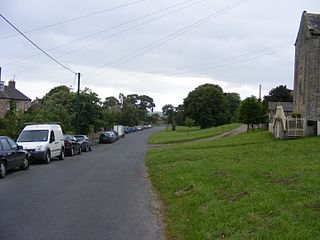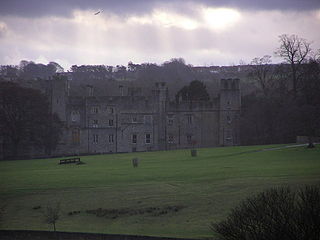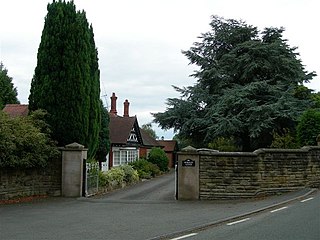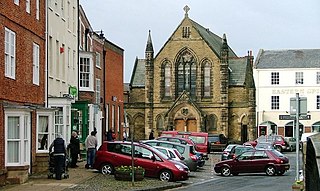
Barnard Castle is a market town in Teesdale, County Durham, England. It is named after the castle around which it was built. It is the main settlement in the Teesdale area, and is a popular tourist destination. The Bowes Museum has the best collection of European fine and decorative arts in the North of England, housed in a "magnificent" 19th-century French-style chateau. Its most famous exhibit is the 18th-century Silver Swan automaton, though art includes work by Goya and El Greco.

Harewood House is a country house in Harewood near Leeds, West Yorkshire, England. Designed by architects John Carr and Robert Adam, it was built, between 1759 and 1771, for wealthy plantation and slave owner Edwin Lascelles, 1st Baron Harewood. The landscape was designed by Lancelot "Capability" Brown and spans 1,000 acres (400 ha) at Harewood.

Lambton Castle located in Chester-le-Street, County Durham, is a stately home, the ancestral seat of the Lambton family, the Earls of Durham. It is a Grade II* listed building.

Malton is a market town, civil parish and electoral ward in North Yorkshire, England. Historically part of the North Riding of Yorkshire, the town is the location of the offices of Ryedale District Council and has a population of around 13,000 people, measured for both the civil parish and the electoral ward at the 2011 Census as 4,888.

Barningham is a village in County Durham, in the Pennines of England.

New Hall Manor is a medieval manor house, now used as a hotel, in Sutton Coldfield, West Midlands, England.

Hart is a village and civil parish in the borough of Hartlepool and the ceremonial county of County Durham, in England. It is situated to the north-west of central Hartlepool.

Sir George Bowes was an English coal proprietor and Whig politician who sat in the House of Commons for 33 years from 1727 to 1760.

Flintham is an English village and civil parish in Nottinghamshire, seven miles from Newark-on-Trent, opposite RAF Syerston on the A46. Its population was 597 at the 2011 Census. The Ham class minesweeper HMS Flintham was named after the village.

Winestead is a village in the East Riding of Yorkshire, England, in an area known as Holderness. It is situated approximately 7 miles (11 km) south-east of the town of Hedon and 1.5 miles (2.4 km) north-west of the village of Patrington. It is situated to the north of the A1033 road. It forms part of the civil parish of Patrington.

Swinton Park, the seat of the Danby family and of the Cunliffe-Lister family is an English country house in Swinton near Masham, North Yorkshire, England. It is set in 200 acres (0.81 km2) of parkland, lakes and gardens. Currently operating as a 32-bedroom hotel, it is surrounded by the family estate in which guests have access to rivers, reservoirs, moorland, dales, and beautiful countryside bordering the Yorkshire Dales National Park. The house is a Grade II* listed building.

Walworth Castle is an 11th Century castle, situated at Walworth, near Darlington, County Durham, England. It is a Grade 1 listed building. It was completed around 1600, probably by Thomas Holt for Thomas Jenison. It stands on the site of a former manor house or castle built in the 12th century by the Hansard family. The estate passed through the hands of the Ayscoughs and Aylmers besides the Hansards and Jenisons, and became a prisoner-of-war camp during World War II and then a girls' boarding school after the war. It has been a hotel since 1981.

Oulton Hall in Oulton, West Yorkshire, England is a Grade II listed building. It was once the home of the Blayds/Calverley family. After a major fire in 1850 the hall was remodelled, but its fortunes declined until it was revived for use as a hotel. It is now a 4 star hotel, part of the QHotels group.

Windlestone Hall is a 19th-century country house situated near Rushyford, County Durham, England. It is a Listed building.

Witton Castle is a much-altered 15th-century castle, which is the centrepiece of a holiday and caravan country park at Witton le Wear, near Bishop Auckland, County Durham. It is a Grade II* listed building.
The Hildyard Baronetcy, of Patrington in the County of York, was a title in the Baronetage of England. It was created on 25 June 1660 for Robert Hilyard, of Patrington and Winestead. The ancient Hildyard family is thought to have been of Norman origin. Robert Hildyard served as Gentleman of the Bedchamber to King Charles I of England and was a major-general in the King's army during the English Civil War. He took part in the Battle of Marston Moor. He was raised to a baronetcy by Charles II following the Restoration of the Monarchy. He was succeeded by his grandson Sir Robert Hildyard, 2nd Baronet. He sat as Member of Parliament for Hedon. He was succeeded by his nephew, the third Baronet, who was Member of Parliament for Great Bedwyn. The latter's son, the fourth Baronet, was High Sheriff of Yorkshire in 1783. On his death in 1814 the baronetcy became extinct.

Goldsborough Hall is a Jacobean stately home located in the village of Goldsborough, North Yorkshire, England. It is a member of the Historic Houses Association. The house itself is a Grade II* listed building. The Hall was built for Sir Richard Hutton (1560–1639) after he acquired the Goldsborough Estate in 1598, and in the 20th century it was home to Princess Mary, Countess of Harewood as her first family home.

Onesacre Hall is a Grade II* Listed building situated in the rural outskirts of the City of Sheffield in South Yorkshire, England. The hall is located on Green Lane in the small hamlet of Onesacre in the suburb of Oughtibridge, 5 miles (8.5 km) north west of the city centre.

Gainford Hall is a privately owned Jacobean manor house at Gainford, County Durham. It is a Grade I listed building but as of 2014 is registered as a Building at Risk.

Horsley Hall was a Jacobethan-style house with formal gardens, near to Gresford, Wrexham County Borough, that was destroyed in 1963.

























